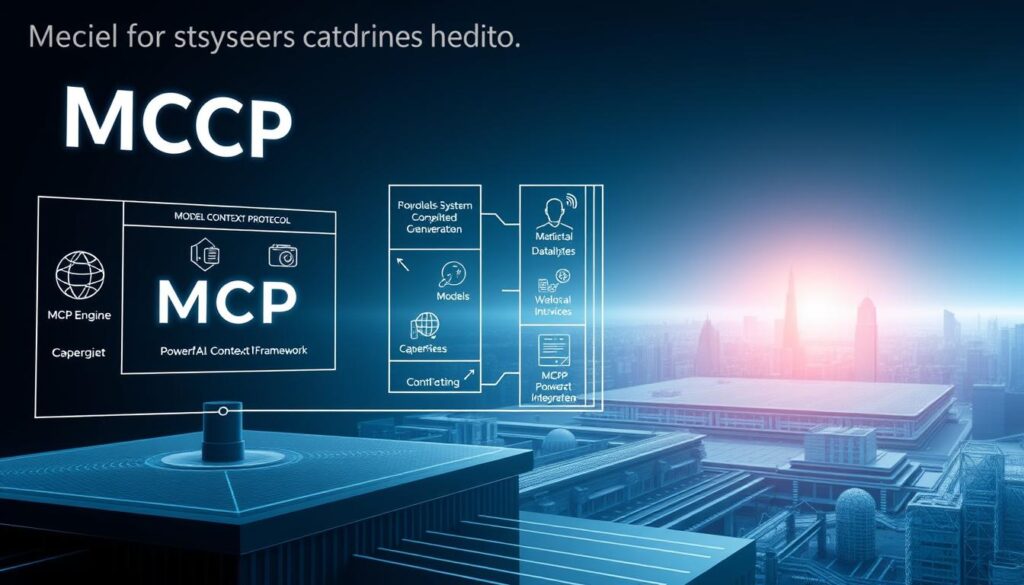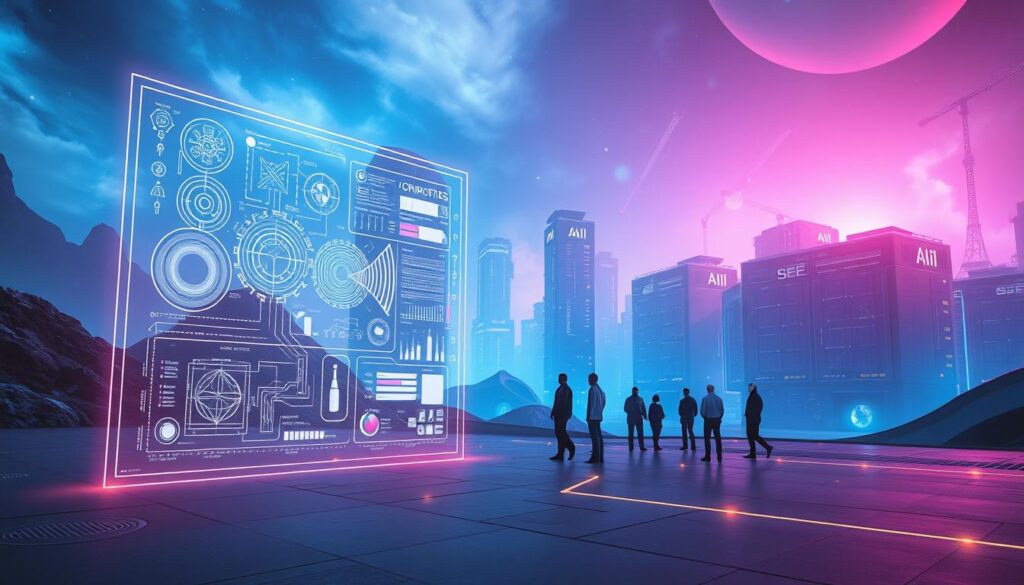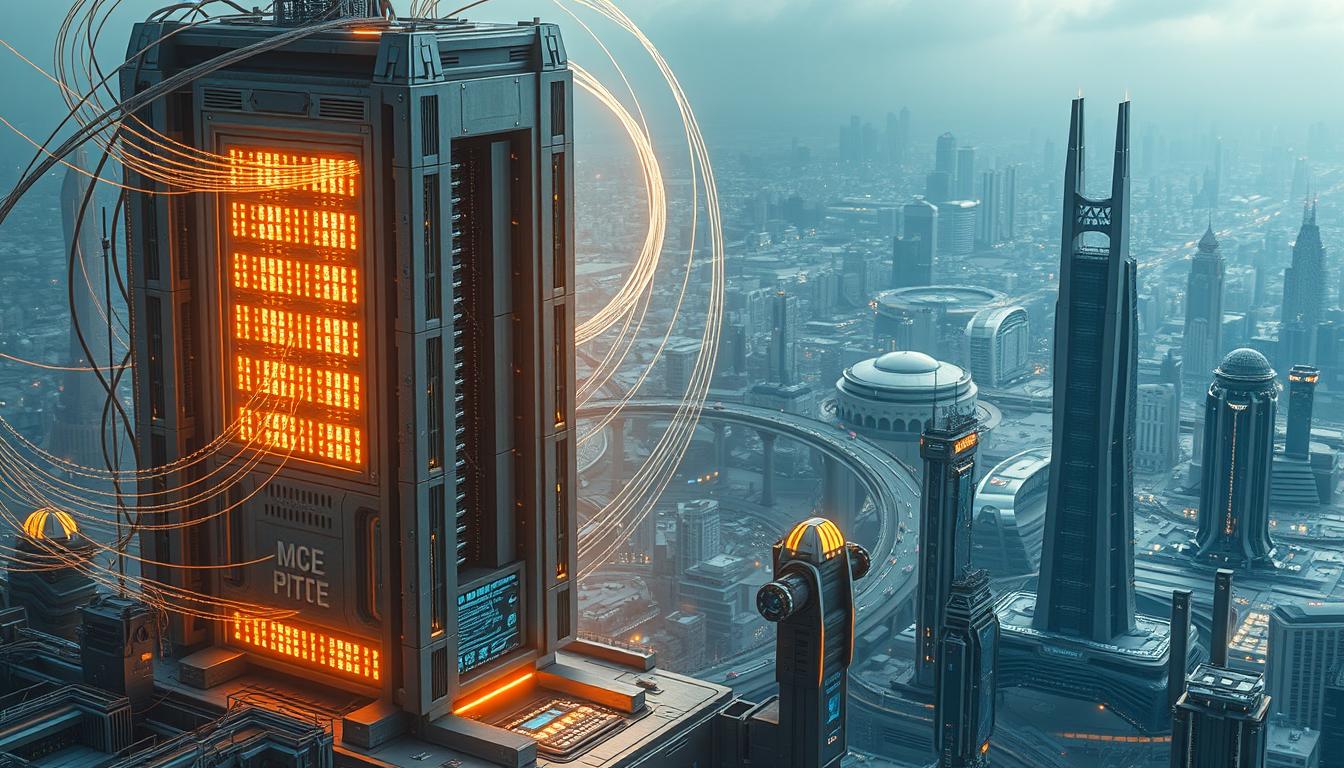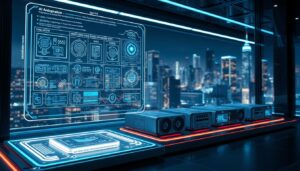The world of artificial intelligence is changing fast with the Model Context Protocol (MCP) arriving in November 2024. This new tech is set to change how AI tools work together. It brings more flexibility and understanding to developers and big companies.
MCP is a big step up in AI tooling. It lets AI agents pick and use tools on their own, based on what they need. This new protocol is going to change what we think AI tools can do.
MCP was inspired by the Language Server Protocol. It’s more than just reacting to things. It lets AI agents make smart choices about which tools to use. This makes technology more responsive and flexible.
Key Takeaways
- MCP enables context-aware AI tool interactions
- Introduced in November 2024 as a revolutionary protocol
- Supports autonomous AI workflow management
- Reduces complexity in AI and tool integrations
- Provides dynamic tool discovery capabilities
- Enhances AI agents’ decision-making processes
Understanding Model Context Protocol (MCP) Fundamentals
The Model Context Protocol (MCP) is a new way for AI tools to work together. It changes how machine learning systems talk to outside resources. MCP is an open standard that makes old API ways of talking seem outdated.

MCP solves old problems with AI tool integration. It makes neural networks and AI systems more dynamic and flexible. Now, AI models can find and use tools on their own, without old barriers.
The Evolution from Traditional Protocols
Old API ways needed special setups for each tool. MCP makes things easier with big benefits:
- Dynamic tool discovery without pre-configuration
- Lightweight JSON-RPC for fast communication
- Support for horizontal and vertical scaling
- Built-in authentication mechanisms
Core Components of MCP Architecture
The MCP architecture is built for complex AI tasks. It has three main parts:
- MCP Hosts: AI apps start the talks
- MCP Clients: They handle the talking
- MCP Servers: They link to data and services
Transforming AI Tool Integration
MCP wants AI systems to work together smoothly. It lets them share data in different digital spaces. With support for STDIO and SSE, MCP gives machine learning apps a lot of freedom.
MCP & AI Tooling: Current State and Implementation

The world of cognitive computing is changing fast. The Model Context Protocol (MCP) is leading this change. It’s making it easier for virtual assistants to work with many tools and platforms.
Developers are now making “everything apps.” These apps use many MCP servers to improve how they work and feel to users.
Cursor is a great example of how MCP works. It’s a code editor that does more than usual. It connects with different servers, like:
- Slack communication platforms
- Resend email services
- Replicate machine learning tools
MCP makes it easy for AI tools to talk to each other. It creates a standard way for them to communicate. This makes it simpler for developers to make apps that are more dynamic and user-friendly.
Here are some benefits of MCP in AI tooling today:
- Real-time data retrieval across platforms
- Simplified external tool interaction
- Enhanced flexibility for virtual assistant development
- Reduced need for custom API configurations
MCP is a big step forward in cognitive computing. It’s helping create smarter and more connected software systems.
Development-Centric Workflows and Applications
The Model Context Protocol (MCP) is changing how developers use AI tools and IDEs. It makes coding easier and faster by streamlining automated machine learning workflows.

Today’s software development needs smart and adaptable tools. MCP meets this need with advanced automated reasoning in development environments.
IDE Integration and Developer Experience
Developers can now use MCP servers easily in their favorite IDEs. This protocol makes powerful integrations that boost productivity:
- Instant access to database operations
- Seamless tool switching without losing context
- Real-time debugging across multiple platforms
Real-time Debugging and Context Management
MCP changes debugging by offering contextual awareness across tools. Developers can track complex interactions and debug AI apps with great precision.
Documentation Generation and Tool Discovery
With MCP, documentation is a dynamic, auto-generated resource. AI agents can quickly find and integrate tools, cutting down learning time and speeding up development.
The future of software development is smart, context-aware, and integrated. MCP is at the forefront of this change.
The Growing Ecosystem of MCP Servers and Clients

The Model Context Protocol (MCP) ecosystem is growing fast. It’s changing AI tooling with its new way of automated machine learning. Since it was made open-source, the community has seen a huge increase in MCP servers and clients.
Key features of the MCP ecosystem include:
- Coding-centric tools dominate the current scene
- Local-first server setups
- New platforms for sharing servers
- Easy ways to find and contribute
By February 2025, over 1,000 MCP servers built by the community will show up. This shows how flexible and appealing the protocol is. The ecosystem’s design makes it easy for AI models to work with different data systems, solving big integration problems.
Developers can now use MCP to:
- Link AI models with many data sources
- Use standard communication protocols
- Make smarter and more aware applications
- Save time and resources in development
The MCP ecosystem keeps getting better. It promises more advanced AI tooling and wider automated machine learning use in many fields.
Authentication and Security Challenges in MCP Implementation
The Model Context Protocol (MCP) brings new security challenges. It needs creative solutions for AI and cognitive computing. As AI grows, strong authentication and access control are key.
AI needs advanced security to handle complex systems and protect data. Today’s security faces big challenges that must be overcome.
Multi-tenant Architecture Solutions
Creating secure multi-tenant environments is crucial. Here are some strategies:
- Strict data isolation between different user groups
- Granular permission management
- Dynamic access control mechanisms
- Encrypted communication channels
Authorization Frameworks and Access Control
Good MCP security needs strong authorization. New solutions aim to create flexible authentication protocols. They support:
- OAuth 2.1-based authorization flows
- Role-based access control
- Comprehensive credential management
- Real-time permission validation
Gateway Security Protocols
Gateway security is vital for AI protection. It ensures safe interactions between AI and data sources.
The future of MCP security is about creating standard, scalable solutions. These must protect well while making things easy for users in AI environments.
Future Possibilities and Market Evolution
The world of neural networks and automated reasoning is on the verge of a big change with Model Context Protocol (MCP). As AI grows, MCP is leading the way in making tool integration easier and AI more powerful.
Here are some exciting things coming for MCP:
- Emergence of sophisticated server registries
- Advanced discovery protocols for AI agents
- Standardized client experiences across platforms
- Dynamic tool selection mechanisms
The competition for companies focused on development will change a lot. Future MCP implementations could prioritize comprehensive toolsets that enable more intelligent and autonomous AI agents. This move goes beyond old API designs to create environments that adapt and understand their context better.
Here’s what the market might look like in the future:
- Machine-readable documentation becoming a critical infrastructure component
- New pricing models driven by agent-driven tool selection
- Enhanced hosting solutions optimized for MCP client capabilities
As neural networks get smarter, MCP will make complex integrations simpler. It will cut down on engineering work and open up new levels of automated reasoning in many fields.
Impact on API Development and Tool Integration
The Model Context Protocol (MCP) is changing how AI tools work with development systems. It’s making API connections smarter and more flexible. This new way is breaking old rules and bringing in fresh ideas.
This change is not just about connecting APIs. Now, automated machine learning lets tools work better together. They can adjust to what developers need and the project’s goals.
Shifting Development Paradigms
MCP brings big changes to how we make software:
- Tools are designed for specific tasks, not just for APIs
- Tools can use resources as needed
- Systems can change quickly to meet new demands
Innovative Pricing and Selection Models
MCP is also changing how we pick and pay for tech tools:
- Prices are based on how well tools perform
- Choosing tools focuses on what they can do in context
- Costs are broken down into smaller parts
With MCP, developers get smarter, more flexible, and affordable ways to integrate tools. These methods fit better with what each project needs.
Conclusion
The Model Context Protocol (MCP) is a big step forward in AI tooling. It helps developers manage complex data interactions in a new way. MCP cuts out middle steps and makes connections simpler, leading to better efficiency and security.
Looking into MCP shows its power to change software development. It makes solving architectural problems easier while keeping data safe. This means developers can use data in real-time without the usual AI system slowdown.
MCP is at the edge of AI tooling innovation. For companies wanting to improve their AI, getting expert help is key. You can find experts at Crowley Media Group, who know about SEO, PPC, AI, and more. Visit crowleymediagroup.com or call (916) 572-9755 to see how MCP can change your AI work.
The future of AI tooling is here, and MCP is leading the charge. It promises safer, more efficient, and easier data interactions for everyone.








